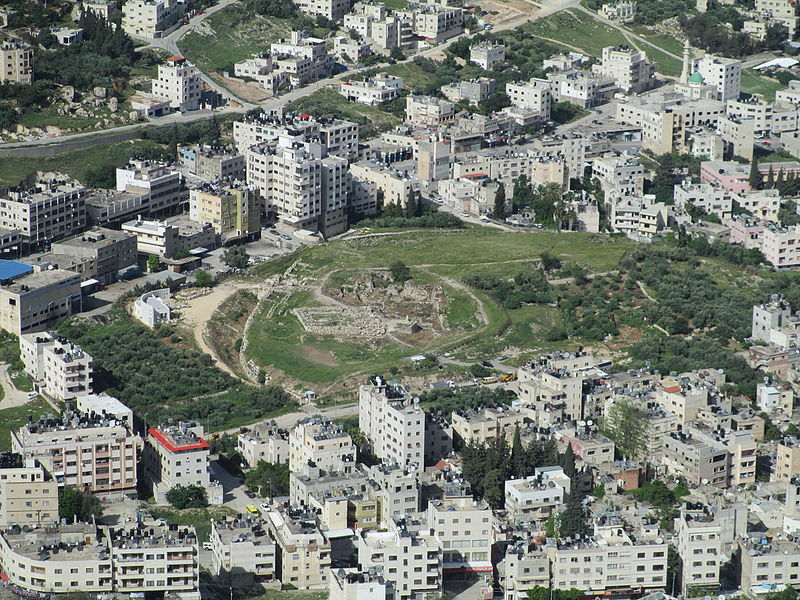Gen 12:6-7 Abram arrives in Canaan and builds an altar by the sacred tree of Moreh at Shechem. Shechem lay in a valley between Mount Ebal (to the north) and Mount Gerizim (to the south) (see 3 on Map 38).

Tel Balata, the site of Shechem, in modern-day Nablus (Avi 1111)
Shechem
The site of Shechem lies within modern-day Nablus (the largest city in Samaria founded by the Roman Emperor Titus in 72AD). The city is located on the only east-west pass through the Central Highlands, at the head of the Wadi Farah leading down to the Jordan crossing at Adam (Damia Bridge).
Shechem was an important Canaanite religious centre. Abram built an altar here to commemorate his meeting with God (see Genesis 12:6) while, later, his grandson Jacob also built an altar here, and buried his wife Rachel’s household gods under the sacred oak tree (see Genesis 35:1-4). Shechem continued to be an important religious centre after the conquest of Canaan under Joshua. At the end of the campaign, Joshua addressed all the people at Shechem and urged them to be faithful to the LORD their God (see Joshua 24:1). He renewed the covenant with God and set up a large sacred stone at Shechem to act as a witness (see Joshua 24:25-27).
In 1404 BC, Joshua died at Shechem, and the mummified body of Abraham’s great-grandson Joseph (which had been brought from Egypt) was laid to rest at Shechem (where he had lived as a young man – see Joshua 24:32 & Genesis 37:12). When the people of Israel turned to Baal after the death of Gideon in c.1170 BC, they worshipped at the great fortress-temple of Baal-berith here at Shechem (see Judges 8:33).
At Tel Balata, to the east of the centre of Nablus, modern visitors can explore the remnants of the Canaanite city of Shechem. The ruins include two gateways, extensive enclosure walls and revetments, and remains of the temple of Baal-berith – known as Migdol Shechem (the 'Tower of Shechem') - which was burnt down by Abimelech in c.1168 BC, with the inhabitants of Shechem inside - see Judges 9:46-49). What is believed to be the large white standing stone (or ‘massebah’) set up by Joshua in c.1404BC (see Joshua 24:25-27) has been re-erected at the centre of the archaeological site.

Joseph's tomb at Shechem (Nablus) ( עדירל )
Half a mile / 1 km north east of Tel Balata is the traditional site of the Tomb of Joseph, covered by a small white-domed Ottoman building. Half a mile / 1 km south of Joseph’s Tomb is the site of Jacob’s Well (see John 4:6), now enclosed within a Greek Orthodox Monastery.
Gen 12:8-9 Abram moves to the hill country between Bethel and Ai. He prays to the LORD and builds an altar here, then moves south towards the Negev Desert.
Gen 12:10-20 Driven by drought and famine in the land of Canaan in c.1853BC, Abram and his wife Sarai journey along the Way of Shur to the well-watered lands of the Nile Delta in Egypt (see 4 on Map 38). Sarai claims to be Abram’s sister rather than his wife and is accepted into the harem of the Egyptian Pharaoh - probably Pharaoh Khety IV. Abram receives sheep, cattle and servants in return. But the deception is uncovered and Abram and Sarai are forced to flee.
Gen 13:1-9 Abram and Sarai return from Egypt to the hill country near Bethel (see 5 on Map 38). The herdsmen quarrel because of insufficient pasture in this dry land. Abram and Lot decide to separate.
Gen 13:10-13 Lot chooses the fertile, well-watered Jordan Valley and pitches his tents near Sodom (see 6 on Map 38). Lot's choice is based on practical considerations – the grazing looks better. But the rich cities of the plain are in moral decadence.
Gen 13:12 Abram stays in the land of Canaan and settles in the Judaean hill country near Bethel. The grazing here is poorer, but Abram stays within the land where God's blessing was promised (see Gen 12:1-3).

Judaean hill country near Bethel
Gen 13:14-17 God renews his covenant promise to Abram: “All this land that you see I will give to you and your descendents for ever” (Genesis 13:15).
Gen 13:18 Abram moves to the great oaks of Mamre near Hebron and builds an altar there (see 7 on Map 38). Hebron (meaning ‘confederacy’), at 3043 ft / 927 m, was the highest town in Palestine (see the feature on Hebron later in this section).
